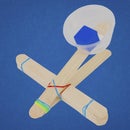Introduction: Open-Ended Hydraulic Machines
This project is very similar to my other Instructable, Simple Hydraulic Machines. The difference here is that students are not shown any examples how to turn their simple hydraulic-powered hinge into something meaningful. Instead, students are taught only how to make a hinge that's actuated by a hydraulic system. The hydraulic hinge doesn't really do much on it's own, so students must decide for themselves what they want it to become.
You can find the lesson plan, 1-page project sheet, and more project ideas at STEM-Inventions.com
Step 1: Materials
The Engineering Creation Kit has everything you need for this project and many more from STEM Inventions.
- Hot glue gun with safety tip
- Craft sticks
- Craft cubes (Bulk pack)
- Craft cubes with holes (Bulk pack)
- 1/8" dowels
- Syringes with tubing & adapters
- Or bulk tubing and syringes
- 4" cable ties
- Masking tape
When you make a purchase through these links, I may earn an affiliate commission at zero cost to you.
Step 2: Part 1 of the Hinge
- Make sure the cubes with holes are aligned as shown or else the skewer will not slide through
- Students should copy this part exactly as shown
Step 3: Part 2 of the Hinge + Connect
- Part 2 is simple - this is the piece that will be pushed by the output piston
- Thread a skewer through all three cubes with holes. Wrap tape around the ends to prevent the skewer from sliding out, then cut off of the excess.
- That's it! Note that the example on the cover image is attached to a base - this is not required. Not all hydraulic machines have the hinge assembly in an upright position.
Step 4: Make It Your Own!
Now that the hinge is finished, it's time for students to consider what they want it to do. If a student is not sure what to make, you can offer some ideas to help get them started, but emphasize that ultimately they can turn it into whatever they want as long as it has a hydraulic-powered hinge.
Here are some things that I've seen students make. Some of these designs utilize a different orientation of the hinge piece:
- Cranes or other "up-down" machines
- Car with a hydraulic convertible roof
- House with hydraulic door
- Tank with hydraulic turret
- Car with a hammer/crusher on the front
- Robot that can bend over (power off) and stand up (power on)
- Adjustable gymnastics course for dolls
- Automatic cork shooter
Step 5: Assemble Hydraulic Systems
- Measure and cut about one foot of tubing
- Fill a syringe completely with water
- Fit the tubing securely over the tip of the syringe
- Press on the syringe to fill the tube with water, pushing out all the air
- Submerge the open end of the tubing and refill the syringe
- Fit the tubing securely over the tip of a completely empty syringe
- Glue a cube with holes on the end of one piston
The fastest way to prepare many hydraulic systems is to complete each step en masse. For example, if you're preparing for 10 students, then you should cut 10 pieces of tubing all at once, then fill 20 syringes, etc. Systematically assembling the hydraulic systems in this way is the most time efficient method.
If the control piston is pulled out of its cylinder, you can fix it by following these steps:
- Push all the water and air out of the output cylinder
- Remove the tubing that is connected to the output cylinder
- Reattach the control piston to its cylinder and refill it with water. If there is air, point the tip upwards and push the air out. Refill completely.
- Reattach the tubing to the output cylinder
Step 6: Attach the Hydraulics
The students can attach the hydraulics at any time after they finish the basic hinge.
The hydraulics can easily be attached in three steps:
- Cable tie the cube with holes that is on the end of the output piston to the underside of the moving hinge piece.
- Get a piece of tape ready. Remove all the water from the output piston and lower it so that the moving piece is at it's lowest desired position.
- Tape the cylinder in place. Use another one or two pieces of tape to secure the cylinder in place.
Step 7: Safety, Tips, and Troubleshooting
- Hydraulics are fun! Be sure to try this out at home, and maybe even make a contraption of your own.
- If a student is absent the first class, you may build the basic hinge for them as part of your prep.
- It's ok if students are not sure what to build at first. Give them 2-5 minutes to think about it, observe what other people are doing, and to play with your example or a unattached hydraulic system.
- Remember to warn your students to not pull too hard on the control piston!













